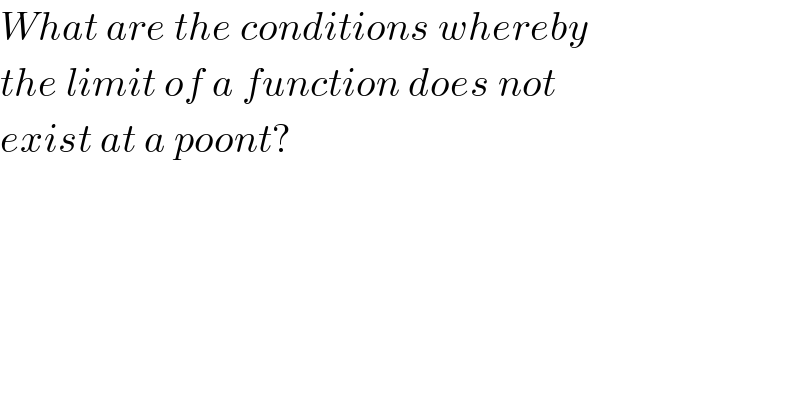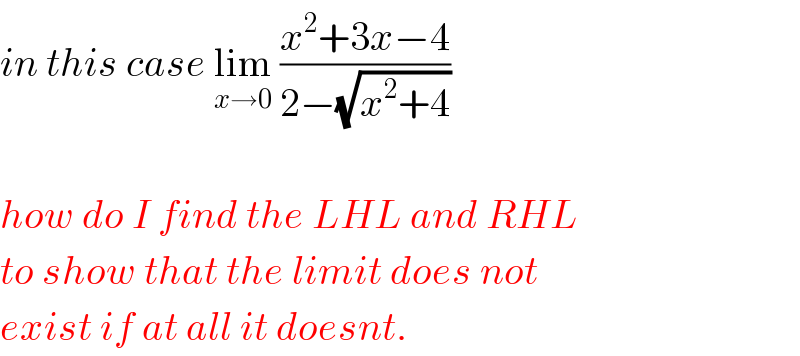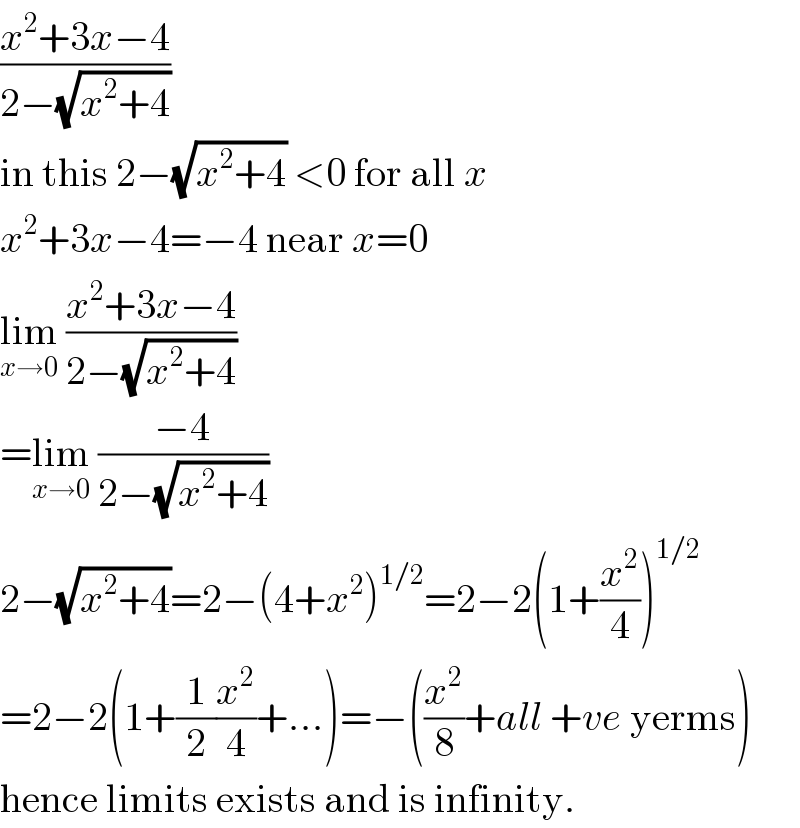
Question Number 27727 by NECx last updated on 13/Jan/18

$${What}\:{are}\:{the}\:{conditions}\:{whereby} \\ $$$${the}\:{limit}\:{of}\:{a}\:{function}\:{does}\:{not} \\ $$$${exist}\:{at}\:{a}\:{poont}? \\ $$
Answered by prakash jain last updated on 13/Jan/18

$$\mathrm{When}\:\mathrm{LHL}\:\mathrm{is}\:\mathrm{not}\:\mathrm{equal}\:\mathrm{to}\:\mathrm{RHL}. \\ $$
Commented by NECx last updated on 13/Jan/18

$${in}\:{this}\:{case}\:\underset{{x}\rightarrow\mathrm{0}} {\mathrm{lim}}\:\frac{{x}^{\mathrm{2}} +\mathrm{3}{x}−\mathrm{4}}{\mathrm{2}−\sqrt{{x}^{\mathrm{2}} +\mathrm{4}}} \\ $$$$ \\ $$$${how}\:{do}\:{I}\:{find}\:{the}\:{LHL}\:{and}\:{RHL} \\ $$$${to}\:{show}\:{that}\:{the}\:{limit}\:{does}\:{not} \\ $$$${exist}\:{if}\:{at}\:{all}\:{it}\:{doesnt}. \\ $$
Commented by prakash jain last updated on 13/Jan/18

$$\frac{{x}^{\mathrm{2}} +\mathrm{3}{x}−\mathrm{4}}{\mathrm{2}−\sqrt{{x}^{\mathrm{2}} +\mathrm{4}}} \\ $$$$\mathrm{in}\:\mathrm{this}\:\mathrm{2}−\sqrt{{x}^{\mathrm{2}} +\mathrm{4}}\:<\mathrm{0}\:\mathrm{for}\:\mathrm{all}\:{x} \\ $$$${x}^{\mathrm{2}} +\mathrm{3}{x}−\mathrm{4}=−\mathrm{4}\:\mathrm{near}\:{x}=\mathrm{0} \\ $$$$\underset{{x}\rightarrow\mathrm{0}} {\mathrm{lim}}\:\frac{{x}^{\mathrm{2}} +\mathrm{3}{x}−\mathrm{4}}{\mathrm{2}−\sqrt{{x}^{\mathrm{2}} +\mathrm{4}}} \\ $$$$=\underset{{x}\rightarrow\mathrm{0}} {\mathrm{lim}}\:\frac{−\mathrm{4}}{\mathrm{2}−\sqrt{{x}^{\mathrm{2}} +\mathrm{4}}} \\ $$$$\mathrm{2}−\sqrt{{x}^{\mathrm{2}} +\mathrm{4}}=\mathrm{2}−\left(\mathrm{4}+{x}^{\mathrm{2}} \right)^{\mathrm{1}/\mathrm{2}} =\mathrm{2}−\mathrm{2}\left(\mathrm{1}+\frac{{x}^{\mathrm{2}} }{\mathrm{4}}\right)^{\mathrm{1}/\mathrm{2}} \\ $$$$=\mathrm{2}−\mathrm{2}\left(\mathrm{1}+\frac{\mathrm{1}}{\mathrm{2}}\frac{{x}^{\mathrm{2}} }{\mathrm{4}}+...\right)=−\left(\frac{{x}^{\mathrm{2}} }{\mathrm{8}}+{all}\:+{ve}\:\mathrm{yerms}\right) \\ $$$$\mathrm{hence}\:\mathrm{limits}\:\mathrm{exists}\:\mathrm{and}\:\mathrm{is}\:\mathrm{infinity}. \\ $$
Commented by prakash jain last updated on 13/Jan/18
both LHL and RHL tend to +infinity
